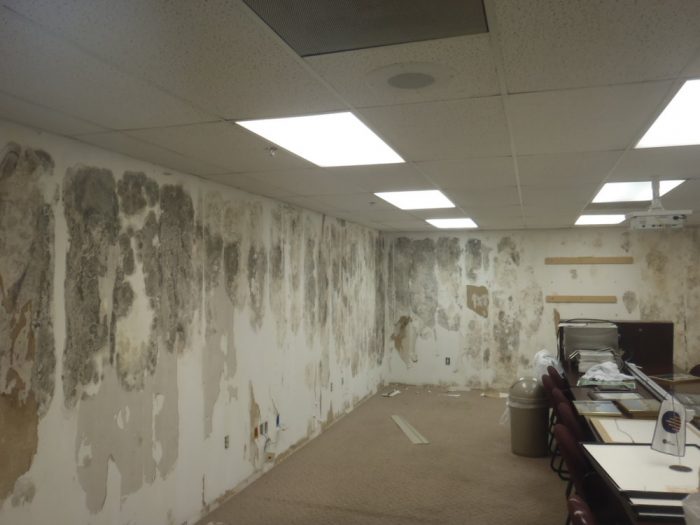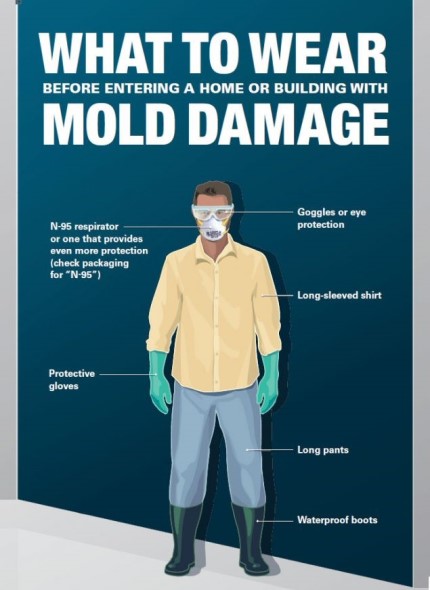How Building Management Companies Can Control Mold

Building management companies face a different set of challenges than homeowners when it comes to mold control. The first and most important is the scale of operations: keeping mold under control across many residential and commercial buildings requires dedicated staff members and an action plan that ensures all buildings are kept in check, even if there’s just one property to be managed.
The US Environmental Protection Agency published the Mold Remediation in Schools and Commercial Buildings Guide, which provides a wealth of information for building managers and property owners. In addition, although multi-family residential dwellings are not mentioned directly in the title, they also fall under the scope of the guide. There are two main reasons why building management companies should keep mold under control:
- Asset Preservation: Mold digests and damages the surfaces it grows on, and fixing the damage represents an extra expense. Since mold prevention has a lower cost than remediation, owners actually get a return on investment from a solid mold prevention program. Thus preventing mold it’s something owners will find as a good management practice and be grateful for.
- Indoor Air Quality and Health: The spores and microbial volatile organic compounds (mVOC) released by mold can trigger allergic reactions and asthma attacks. Individuals who suffer from both asthma and mold allergies are the most susceptible, since the chance of an asthma attack is very high upon exposure to mold. However, non-allergic people may also develop health issues due to long term exposure to mold-polluted air.
Modern buildings have an airtight construction to reduce air leakage and the associated HVAC expenses, but this has also led to an increased occurrence of mold, given that spores and moisture are easily trapped indoors.
For building management companies, keeping mold under control is both socially responsible and cost-effective.
There is a very important rule to keep in mind when devising a mold control program: Eliminating mold directly is virtually impossible because its spores are tough and found everywhere. Controlling moisture is a much simpler approach since mold typically dies off when relative humidity is reduced below 60%. In turn, relative humidity can be kept under watch with a reliable indoor air monitoring system such as Foobot.
Cost of Remediation: Avg. National Cost of Mold Removal in an Office
Mold removal costs vary a lot between cases according to factors such as square feet, location of the infestation, as well as cost of repairs, and materials. This figure does take into account the cost for lost wages, overhead, fines, etc.
Cost of Prevention – Air Quality Monitoring System Consisting in 3 Foobots
The WELL certification recommends one sensor per 3,500 sq. ft. . However, we at Foobot recommend one sensor per 1,000 sq. ft., to cover the different rooms and get a more accurate picture of air quality. The cost above is for a 3,000 sq.ft office space.
How Adequate Building Maintenance Prevents Mold
Mold growth is associated with excessive moisture, and moisture is often the result of poor building maintenance. For example, all the following issues can be prevented:
- Plumbing leaks.
- Building envelope leaks.
- Poor insulation in pipes and other cold surfaces.
- Stagnant air due to deficient ventilation.
- Dirty or obstructed air conditioner drip pans.
- Leaks in the venting systems of moisture-generating appliances.
An adequate maintenance program can help address all these issues, ensuring that mold is kept under control. Although mold can be detected by its odor, by the time it is evident the growth may already be very large. At best, odor is an indication that a hidden patch of mold has managed to escape inspections and maintenance activities.
The first decision to take after detecting mold issues in real estate is to decide between in-house remediation or hiring a contractor for the job. Mold patches smaller than 10 ft2 can generally be addressed in-house with minimal risk, but for larger infestations it is strongly advised that you get a professional opinion – if highly toxic mold species are detected or the difficulty of the task is too high, professional remediation by an external contractor may be the only safe option.
In-House Mold Remediation Methods
If the mold remediation task is considered safe for your maintenance staff, you can follow the steps in this section to achieve the best results. Keep in mind that the issues generating moisture should be fixed first, or mold remediation efforts will be in vain as it will simply grow again.
1) Wet Vacuum
As implied by their name, wet vacuum cleaners are designed to collect water along with pollutant substances, making them an excellent choice to eliminate both mold and the moisture that sustains it. Wet vacuuming is recommended for hard surfaces and carpets, but not for porous materials. It is also important to note that wet vacuuming a dry surface may actually spread mold spores – only use the method if water is present. After finishing, make sure that the wet vacuum interior is cleaned thoroughly and dried, since mold may adhere to its interior surfaces.
2) Damp Wipe
When dealing with hard surfaces, mold can generally be scrubbed away with water and detergent. Just make sure the surface is dried well after finishing, or mold spores left behind will hatch. Keep in mind that killing mold is not enough to control the issue – it is allergenic even when dead, and some species may actually become more toxic after decomposition. Mold removal is a key element of effective remediation.
Make sure that your maintenance staff does not apply paint over mold-infested surfaces, even if the mold is already dead. If you proceed, a barrier of dead mold will be trapped between the paint and the surface, and it will simply peel once it dries.

Remember
Eliminating mold directly is virtually impossible because its spores are tough and found everywhere. Controlling moisture is a much simpler approach.
3) HEPA Vacuum
A HEPA vacuum should be used for final cleanup once the affected area has been remediated and dried, and objects and materials contaminated beyond repair have been removed. Keep in mind that dust may have accumulated around the area where mold was remediated, and it should be cleaned with the HEPA vacuum as well. After finishing, the used filter must be sealed in a plastic bag and discarded.
4) Last Resort: Discarding Affected Objects and Construction Materials
Some construction materials, furniture and objects may be impossible to clean due to the extent of mold damage, especially if they are porous. Upon removal, these should be placed inside two bags made from 6-mil polyethylene. Large objects that can’t be placed in a bag can be sealed with polyethylene sheets and duct tape.
Personal Protection Equipment (PPE) for Your Maintenance Staff
Before any mold inspection or remediation activities, make sure that your staff is protected. Mold spores and volatile compounds can irritate the skin, eyes and respiratory tract, which means your staff should wear at least an N-95 respirator, gloves and goggles.
The PPE is required even if mold remediation will be carried out by an external contractor, since they will need assistance from your maintenance staff. You should also request that your contractor’s personnel wears this gear, ensuring that everyone will be safe from mold. This equipment should be worn even if your maintenance personnel is investigating areas where mold growth is suspected: it has a tendency to grow in dark and damp places away from sight, and if a large mold growth is disrupted when discovered, a large volume of spores and microbial VOCs will be released at once.
Keep in mind that this is the minimal equipment necessary for routine mold remediation, where the extent of the damage or toxicity of the mold species is low. Additional protection gear may be required in cases of severe mold infestation. The US EPA establishes three levels of mold protection gear:
- Minimum: N-95 respirator, gloves and goggles. This protection gear is required when mold damage is relatively low (affected area under 10 ft2).
- Limited: N-95 respirator or half-face respirator with HEPA filter, gloves, goggles and disposable overalls. This protection gear is required for most cases where mold growth ranges between 10 and 100 ft2.
- Full: Headgear, full-face respirator with HEPA filter, disposable full body clothing and foot coverings. This degree of protection is required when mold growth exceeds 100 ft2, but may be required for smaller areas at the discretion of a professional remediator. For example, full-body protection may be required if highly toxic mold species are found or if there is a high risk of releasing large amounts of spores.
Mold Containment During Remediation
Containment has the purpose of preventing the spread of mold and dust to other building areas during remediation. The US EPA establishes two protection levels: limited and full, where limited containment applies for areas between 10 and 100 ft2, and full containment applies when mold growth exceeds 100 ft2.
In both cases, the containment area should be negatively pressurized by exhausting air directly outdoors. The polyethylene sheets circling the containment area should billow inwards like sails if negative pressurization is working effectively – stop remediation activities and re-establish negative pressure if they are billowing outwards or not at all.
Limited Containment
This containment level is recommended for mold-affected areas between 10 and 100 ft2, unless a mold remediation professional suggests full containment. Limited containment consists of the following elements:
- One layer of fire-retardant 6-mil polyethylene sheeting from the floor to the ceiling, totally enclosing the remediation area. A slit covered by a flap should be used as an entry point.
- Any supply and return air vents in the area being remediated should be blocked as well.
- HEPA-filtered exhaust fan for negative pressurization.
Full Containment
This containment level is recommended for mold-infested areas larger than 100 ft2, or for smaller areas according to the judgment of a remediation professional. Full containment is composed of the same elements as limited containment, with one difference: two layers of polyethylene sheeting are used instead of one, with an airlock chamber to be used as an entry point.
Better Safe Than Sorry
Building management companies should not overlook mold, or they may have to carry out expensive reparations, or even face legal action from both owners and tenants if the latter’s health is affected and/or the properties are damaged by poor mold control.
Small mold growths (below 10 ft2) can generally be remediated by your maintenance staff, but seek professional advice if the infestation is more severe, to avoid exposing your personnel and tenants to large amounts of spores, microbial VOCs and/or toxins.
Nevertheless, remediation may not solve the problem and most likely it will be much more expensive than implementing a prevention plan in which the main goal is to keep relative humidity below 60%. The best way to ensure this is accomplished is through a careful monitoring of indoor air, a task that can be performed automatically by the newest Foobot technology. Learn more here.
